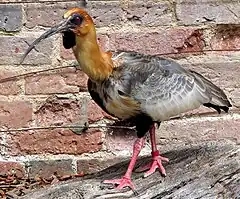| Theristicus[1] | |||
| Wagler, 1832[2] | |||
 Przedstawiciel rodzaju – ibis maskowy (T. melanopis) | |||
| Systematyka | |||
| Domena | |||
|---|---|---|---|
| Królestwo | |||
| Typ | |||
| Podtyp | |||
| Gromada | |||
| Podgromada | |||
| Infragromada | |||
| Rząd | |||
| Podrząd | |||
| Rodzina | |||
| Rodzaj |
Theristicus | ||
| Typ nomenklatoryczny | |||
|
Tantalus melanopis J.F. Gmelin, 1789 | |||
| Synonimy | |||
| |||
| Gatunki | |||
| |||
Theristicus – rodzaj ptaków z rodziny ibisów (Threskiornithidae).
Zasięg występowania
Rodzaj obejmuje gatunki występujące w Ameryce Południowej[5].
Morfologia
Długość ciała 71–76 cm; masa ciała 1466–1550 g[5].
Systematyka
Etymologia
- Theristicus: gr. θεριστικος theristikos „żąć”, od θεριστρον theristron „sierp”[6].
- Harpiprion: gr. ἁρπη harpē „sierp, hak”; πριων priōn, πριονος prionos piła, od πριω priō „piłować”[7]. Gatunek typowy: Ibis plumbeus Temminck, 1823 (= Ibis caerulescens Vieillot, 1817).
- Molybdophanes: gr. μολυβδοφανης molubdophanēs „ołowiany, koloru ołowiu”, od μολυβδος molubdos „ołów”; -φανης -phanēs „pokazywanie, wygląd”, od φαινω phainō „pokazać, ukazać”[8]. Gatunek typowy: Ibis caerulescens Vieillot, 1817.
Podział systematyczny
Do rodzaju należą następujące gatunki[9]:
- Theristicus caerulescens (Vieillot, 1817) – ibis ołowiany
- Theristicus caudatus (Boddaert, 1783) – ibis płowy
- Theristicus branickii von Berlepsch & Stolzmann, 1894 – ibis Branickiego – takson wyodrębniony z T. melanopis[10]
- Theristicus melanopis (J.F. Gmelin, 1789) – ibis maskowy
Przypisy
- ↑ Theristicus, [w:] Integrated Taxonomic Information System (ang.).
- ↑ Wagler 1832 ↓, s. kol. 1231.
- ↑ Wagler 1832 ↓, s. kol. 1232.
- ↑ H.G.L. Reichenbach: Avium systema naturale. Das natürliche system der vögel mit hundert tafeln grösstentheils original-abbildungen der bis jetzt entdecken fast zwölfhundert typischen formen. Vorlaüfer einer iconographie der arten der vögel aller welttheile. Dresden und Leipzig: Expedition der vollständigsten naturgeschichte, 1850, s. xiv. (niem.).
- 1 2 D.W. Winkler, S.M. Billerman & I.J. Lovette: Ibises and Spoonbills (Threskiornithidae), version 1.0. W: S.M. Billerman, B.K. Keeney, P.G. Rodewald & T.S. Schulenberg (red.): Birds of the World. Ithaca, NY: Cornell Lab of Ornithology, 2020. DOI: 10.2173/bow.thresk1.01. [dostęp 2020-05-28]. (ang.).

- ↑ The Key to Scientific Names ↓, Theristicus [dostęp 2022-01-31].
- ↑ The Key to Scientific Names ↓, Harpiprion [dostęp 2022-01-31].
- ↑ The Key to Scientific Names ↓, Molybdophanes [dostęp 2022-01-31].
- ↑ Systematyka i nazwy polskie za: P. Mielczarek & M. Kuziemko: Rodzina: Threskiornithidae Poche, 1904 - ibisy - Ibises (Wersja: 2019-10-12). [w:] Kompletna lista ptaków świata [on-line]. Instytut Nauk o Środowisku Uniwersytetu Jagiellońskiego. [dostęp 2019-11-07].
- ↑ N.J. Collar & J.P. Bird. Phenotypic discrimination of the Andean Ibis. „The Wilson Journal of Ornithology”. 123 (3), s. 459–463, 2011. DOI: 10.1676/10-162.1. (ang.).
Bibliografia
- J.G. Wagler. Neue Sippen und Gattungen der Säugthiere und Vögel. „Isis von Oken”. 1832, s. kol. 1218–1235, 1832. (niem.).
- The Key to Scientific Names, J.A. Jobling (red.), [w:] Birds of the World, S.M. Billerman et al. (red.), Cornell Lab of Ornithology, Ithaca (ang.).
This article is issued from Wikipedia. The text is licensed under Creative Commons - Attribution - Sharealike. Additional terms may apply for the media files.